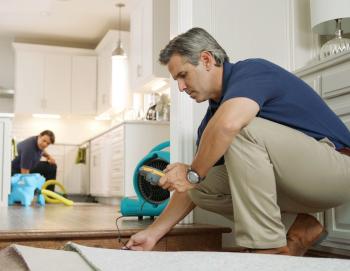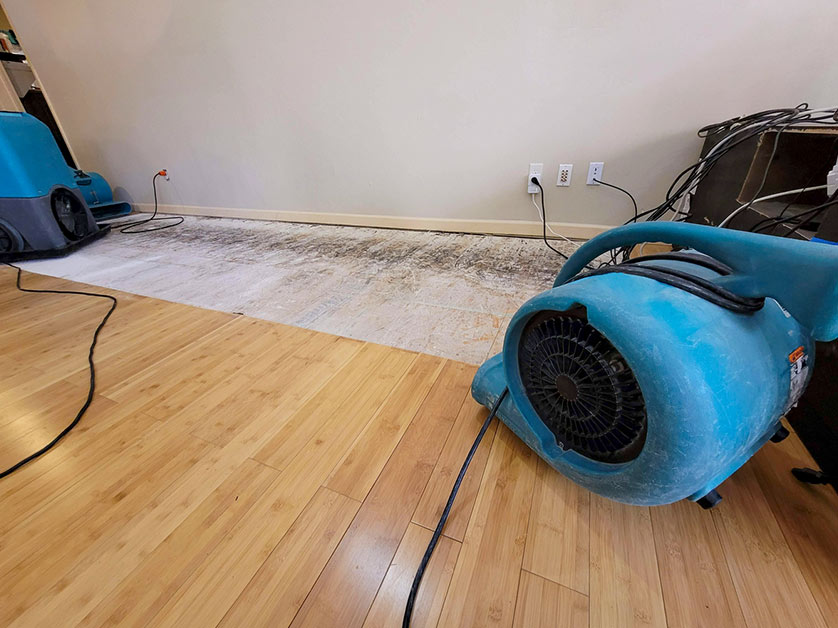Water Damage Restoration 101: Recognizing the Process and Expense
Water damage can strike unexpectedly, leaving house owners in a state of complication. Comprehending the repair process is vital for reliable recovery. From examining the damage to selecting the ideal solution company, each action influences the general result and price. Variables such as the sort of water damage and necessity also play a substantial duty. What are the particular methods made use of in remediation, and just how can one prepare for potential expenses?
Kinds Of Water Damage

Preliminary Analysis and Examination

Water Extraction Strategies
Following the first analysis, reliable water removal methods are employed to mitigate damage and protect against additional concerns. These strategies include using customized devices such as completely submersible pumps and industrial-grade vacuums - Water Damage Restoration. The selection of technique relies on the quantity of water existing and the sort of products influenced. For standing water, submersible pumps are usually made use of for fast removal, while vacuums are optimal for extracting water from rugs and upholstery. Additionally, advanced techniques like water removal floor coverings might be utilized for hard-to-reach locations - Water Damage Restoration. The goal is to eliminate as much water as possible, minimizing the capacity for mold and mildew development and structural damage. Trigger and efficient water removal is vital in the general water damage reconstruction process
Drying and Dehumidification Process
Once the water extraction is total, the drying and dehumidification procedure comes to be crucial to restoring the affected area. This stage generally employs industrial-grade dehumidifiers and air movers to efficiently minimize dampness levels. The dehumidifiers attract in moist air, removing excess humidity, while air moving companies flow air to increase evaporation. Surveillance devices is often made use of to track moisture and temperature level levels, making sure suitable drying out problems. The duration of this procedure can vary depending on the level of the water damage and environmental aspects. It is necessary to completely completely dry all affected materials, consisting of walls, flooring, and home furnishings, to stop mold and mildew development and architectural damage. Correct execution of this step is critical for a successful remediation end result.
Cleaning Up and Sterilizing Afflicted Locations
A thorough initial assessment and inspection of affected locations is vital to determine contamination degrees as soon as the drying procedure is total. Water Damage Restoration. Reliable cleaning techniques and ideal products should then be utilized to get rid of particles and spots. Finally, sanitization and sanitation methods are necessary to guarantee that unsafe pathogens are removed, bring back the room to a safe problem
First Assessment and Inspection
Prior to starting any repair initiatives, a complete first evaluation and examination of the affected areas are crucial for reliable cleansing and sanitizing. This procedure involves determining the degree of water damage, establishing the resource of the water invasion, and evaluating the materials influenced. Examiners generally seek signs of mold and mildew growth, architectural integrity concerns, and damaged items. The evaluation additionally includes examining wetness degrees utilizing specific equipment to guarantee no hidden water pockets stay, as these can cause more problems. Documenting the findings is vital for preparing the next action in the repair process. A detailed preliminary evaluation makes it possible for remediation experts to create a targeted approach for efficient cleansing and disinfecting, inevitably reducing damage and health and wellness risks.
Cleaning Up Strategies and Products
Reliable cleaning and sterilizing of water-damaged areas need a selection of items and techniques tailored to the particular products affected. For permeable surfaces like drywall and carpeting, removal techniques are important to eliminate excess moisture, adhered to by deep cleansing with specialized detergents. Non-porous products such as ceramic tile or steel can be cleaned up making use of commercial-grade cleansers that efficiently get rid of impurities. Vapor cleansing is one more efficient technique, especially for carpets and upholstery, as it uses heats to remove bacteria and mold and mildew (Flood Cleanup Services). In addition, green items are significantly popular for their safety and efficacy - Water Extraction And Drying. Ultimately, choosing the suitable cleansing methods and products not only ensures prompt sanitation yet likewise aids in stopping additional damage and health hazards related to water invasion
Sanitization and Disinfection Methods
When addressing water damage, proper sanitization and sanitation approaches are necessary to guarantee the safety and security and health and wellness of the damaged atmosphere. After initial cleansing, surface areas should be treated with appropriate anti-bacterials to remove microorganisms, mold and mildew, and germs that flourish in wet problems. Common techniques consist of the use of EPA-approved chemical disinfectants, which can be applied via spraying or cleaning techniques. In addition, ultraviolet (UV) light systems can efficiently disinfect locations by neutralizing microorganisms without extreme chemicals. The selection of method typically depends upon the kind of products influenced and the level of contamination. Ultimately, extensive sanitization not just recovers a secure space yet additionally assists stop future wellness threats related to lingering moisture and mold growth.

Repairs and Restoration Options
Assessing the damage brought on by water exposure is vital for figuring out the appropriate repair work and repair alternatives. Homeowners may deal with various problems, consisting of harmed drywall, distorted flooring, and compromised structural elements. Depending on the extent of the damage, repair services might include replacing sections of drywall, mounting brand-new floor covering, or enhancing architectural beam of lights. In instances of extreme damage, full substitute of damaged materials may be needed. In addition, specialist conservators commonly advise utilizing dampness meters to examine surprise dampness levels before selecting the finest program of activity. It is very important to act without delay to stop mold growth and additional wear and tear. Choosing the right alternatives not just brings back the residential or commercial property but also assures long-lasting security and functionality.
Elements Influencing Restoration Expenses

The degree of water damage straight impacts the reconstruction costs home owners can expect to sustain. Elements such as the resource of the water, the period of exposure, and the affected products greatly influence rates. Tidy water damage from a broken pipe is normally much less pricey to restore contrasted to damage created by sewage. Additionally, the degree of contamination determines the need for specialized cleaning and disposal Visit Your URL services, additionally raising costs. Geographic area additionally contributes, as local labor prices and schedule of restoration services can differ. The necessity of the response influences prices; quicker treatments normally lead to decrease overall expenses by stopping additional damage. Comprehending these variables is crucial for property owners when approximating repair costs.
The 3 main types of water damage are categorized based on contamination levels: tidy water, grey water, and black water. A comprehensive initial evaluation and assessment are essential actions in the water damage repair procedure. For standing water, submersible pumps are generally utilized for rapid elimination, while vacuum cleaners are excellent for removing water from rugs and upholstery. The level of water damage straight influences the remediation costs house owners can anticipate to incur. Clean water damage from a broken pipeline is typically less pricey to bring back contrasted to damage created by sewer.